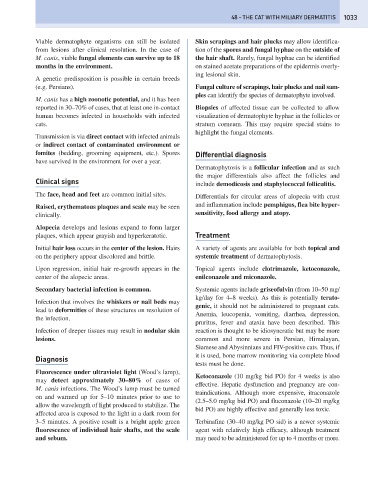Page 1041 - Problem-Based Feline Medicine
P. 1041
48 – THE CAT WITH MILIARY DERMATITIS 1033
Viable dermatophyte organisms can still be isolated Skin scrapings and hair plucks may allow identifica-
from lesions after clinical resolution. In the case of tion of the spores and fungal hyphae on the outside of
M. canis, viable fungal elements can survive up to 18 the hair shaft. Rarely, fungal hyphae can be identified
months in the environment. on stained acetate preparations of the epidermis overly-
ing lesional skin.
A genetic predisposition is possible in certain breeds
(e.g. Persians). Fungal culture of scrapings, hair plucks and nail sam-
ples can identify the species of dermatophyte involved.
M. canis has a high zoonotic potential, and it has been
reported in 30–70% of cases, that at least one in-contact Biopsies of affected tissue can be collected to allow
human becomes infected in households with infected visualization of dermatophyte hyphae in the follicles or
cats. stratum corneum. This may require special stains to
highlight the fungal elements.
Transmission is via direct contact with infected animals
or indirect contact of contaminated environment or
fomites (bedding, grooming equipment, etc.). Spores Differential diagnosis
have survived in the environment for over a year.
Dermatophytosis is a follicular infection and as such
the major differentials also affect the follicles and
Clinical signs include demodicosis and staphylococcal folliculitis.
The face, head and feet are common initial sites. Differentials for circular areas of alopecia with crust
Raised, erythematous plaques and scale may be seen and inflammation include pemphigus, flea bite hyper-
clinically. sensitivity, food allergy and atopy.
Alopecia develops and lesions expand to form larger
plaques, which appear grayish and hyperkeratotic. Treatment
Initial hair loss occurs in the center of the lesion. Hairs A variety of agents are available for both topical and
on the periphery appear discolored and brittle. systemic treatment of dermatophytosis.
Upon regression, initial hair re-growth appears in the Topical agents include clotrimazole, ketoconazole,
center of the alopecic areas. enilconazole and miconazole.
Secondary bacterial infection is common. Systemic agents include griseofulvin (from 10–50 mg/
kg/day for 4–8 weeks). As this is potentially terato-
Infection that involves the whiskers or nail beds may
genic, it should not be administered to pregnant cats.
lead to deformities of these structures on resolution of
Anemia, leucopenia, vomiting, diarrhea, depression,
the infection.
pruritus, fever and ataxia have been described. This
Infection of deeper tissues may result in nodular skin reaction is thought to be idiosyncratic but may be more
lesions. common and more severe in Persian, Himalayan,
Siamese and Abysinnians and FIV-positive cats. Thus, if
it is used, bone marrow monitoring via complete blood
Diagnosis
tests must be done.
Fluorescence under ultraviolet light (Wood’s lamp),
Ketoconazole (10 mg/kg bid PO) for 4 weeks is also
may detect approximately 30–80% of cases of
effective. Hepatic dysfunction and pregnancy are con-
M. canis infections. The Wood’s lamp must be turned
traindications. Although more expensive, itraconazole
on and warmed up for 5–10 minutes prior to use to
(2.5–5.0 mg/kg bid PO) and fluconazole (10–20 mg/kg
allow the wavelength of light produced to stabilize. The
bid PO) are highly effective and generally less toxic.
affected area is exposed to the light in a dark room for
3–5 minutes. A positive result is a bright apple green Terbinafine (30–40 mg/kg PO sid) is a newer systemic
fluorescence of individual hair shafts, not the scale agent with relatively high efficacy, although treatment
and sebum. may need to be administered for up to 4 months or more.

